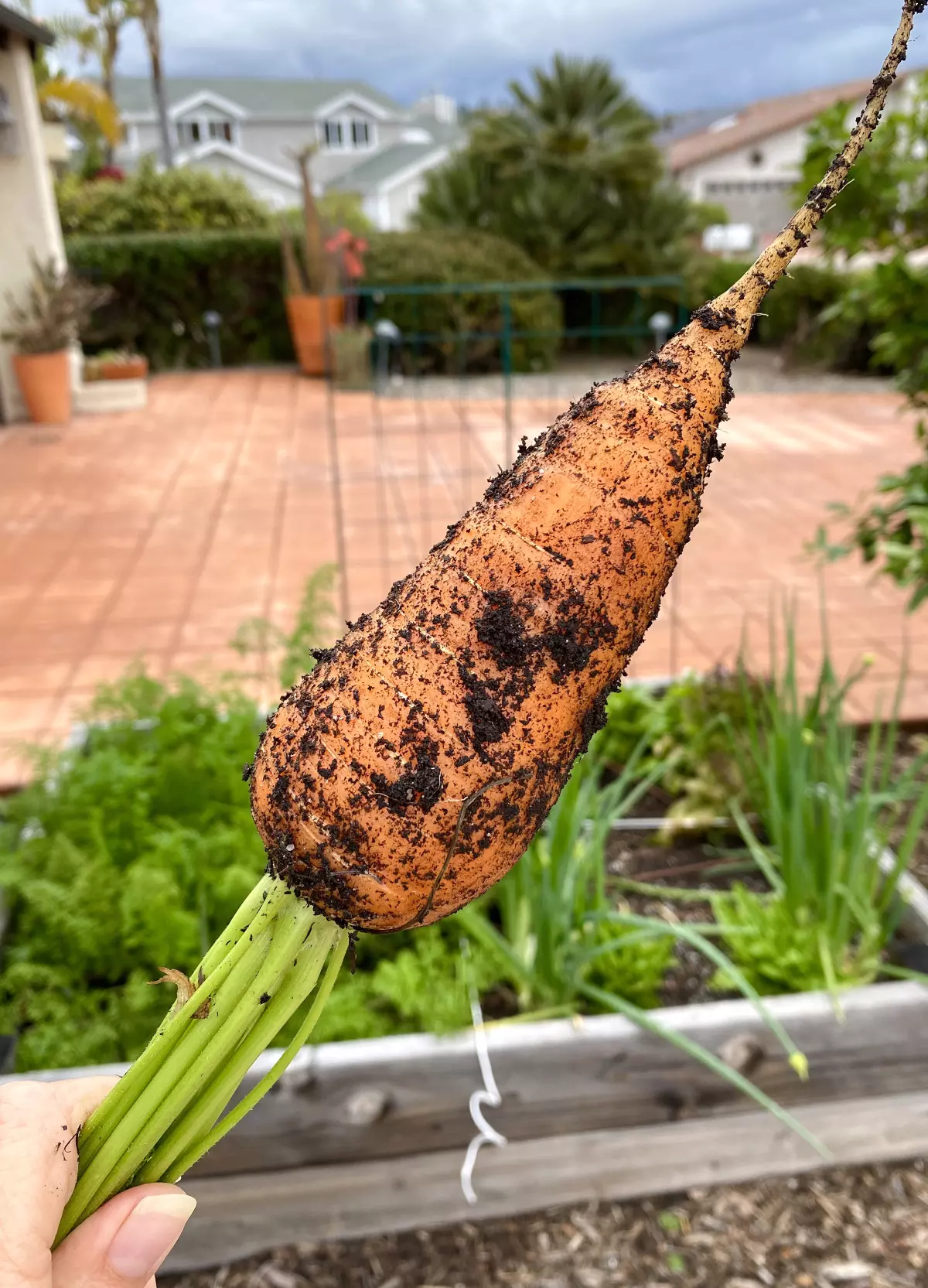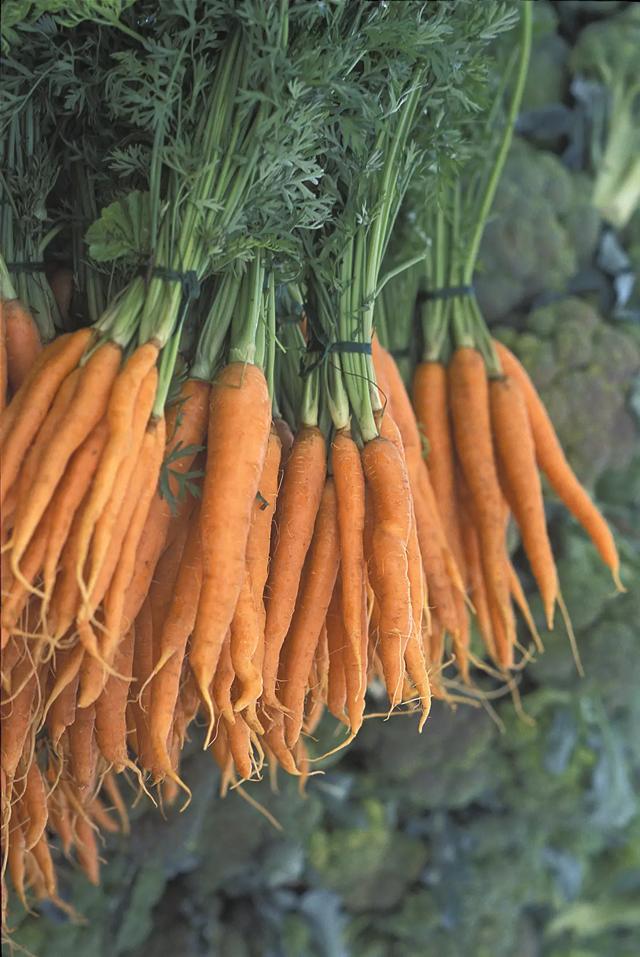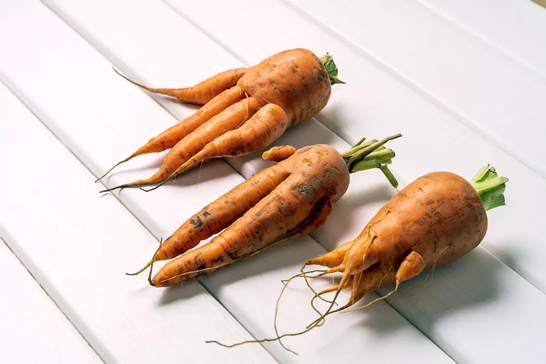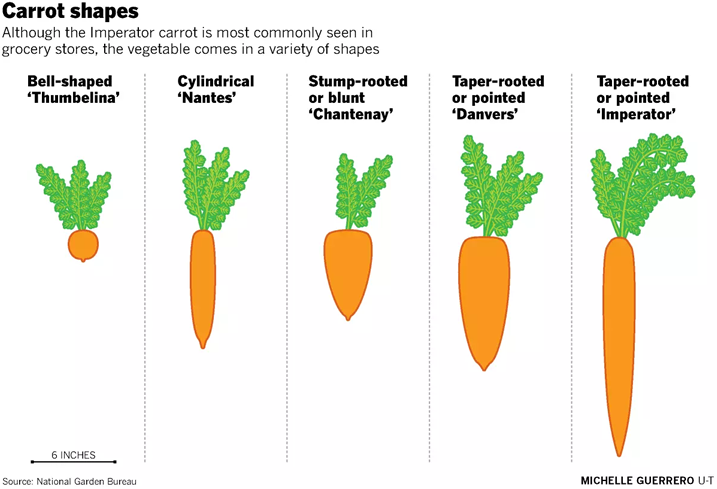Region’s long season gives ample time to grow carrots

Danvers are one of the tapered-rooted or pointed carrot varieties. (Jodi Bay)
Hearty root vegetable should do well if started from seed in loose, well-draining soil
BY JODI BAY
(This article first appeared in the January 9, 2021 edition of the San Diego Union-Tribune)
Carrots are an easy vegetable to grow, and many varieties exist, one of which will surely do well in your garden and delight your palate.
Carrots are affected by few diseases or pests. Most issues are cultural, which means issues arise from environmental or growing conditions. With a few tips, your vegetable garden will provide bundles of tasty carrots.

The long, taper-rooted Imperator is the carrot variety most commonly seen in grocery stores. (UC Agriculture and Natural Resources)
First discovered in Afghanistan around A.D. 600, the original carrots were purple, not orange. The first orange carrot was hybridized in Holland in the 17th century and then brought to North America. Carrots currently come in a variety of colors — orange, red, purple, yellow and white.
Regardless of color, all varieties are nutritious — containing potassium, Vitamin C and Vitamin K — and are rich in fiber and antioxidants.
Carrots are categorized into four shapes:
- Taper-rooted or pointed carrots decrease in diameter from crown to root tip. Common varieties are Danvers and Imperator. Imperator can grow upwards of 8 inches and is the variety commonly seen in grocery stores.
- Stump-rooted or blunt carrots have a blunt tip and are shorter than taper-rooted varieties. A widely available variety is Chantenay.
- Cylindrical carrots have a slight taper and are named for their shape. They are also short with a blunt tip and are wider than other carrots. Nantes is an example of a cylindrical carrot variety.
- Ball-shaped carrots are spherical. Thumbelina is a common variety.
Grow carrots from seeds rather than starts. They are a cool-season vegetable, which means they grow best when the soil temperature is between 65 and 80 degrees. In San Diego County, plant carrot seeds along the coast from September through April. For inland gardens, the best months are September through March.
They need loose, well-drained soils with consistent watering for healthy growth. Adding compost and a vegetable fertilizer to the soil two weeks prior to planting will help the root grow to its full size and improve drainage. Shorter carrots grow better in heavy soil while longer carrots do best in lighter soil. Ball-shaped and stump-rooted carrots do well in containers and in heavy or rocky soil.
Read the seed package for planting depth, but typically carrot seeds are planted shallowly at about 1/8 inch deep. As the seed germinates, it sends down a threadlike tap root. Keeping the soil damp ensures that water descends into the soil, keeping the tap root moist, which helps the carrots grow straight.
Once the seeds start germinating, pull out or thin the weakest plants by cutting the green tops at ground level with a pair of small scissors. Cutting may need to be done a second time as the carrots grow. Carrot season is long in San Diego County, so consider succession planting and plant seeds monthly during the cool season.
One issue gardeners sometimes face when planting carrots, or any small seed, is spacing the seeds appropriately to ensure that each seed has room to grow. If this is a concern, purchase or make seed tape. Seed tape is a roll or strip of tissue paper with the seeds already imbedded at the correct spacing. Using seed tape will remove the challenge of getting the correct seed spacing. Instructions on making seed tape can be found here. Try it with children. It’s fun and a good way to get children interested in gardening. Also, there is no rule that carrots have to be grown in rows. Consider scatter or broadcast seeding. It’s natural and requires much less work.
A few problems that carrot gardeners should look for are “forking,” “green shoulders” and “cracking.”
“Forking” is when the carrot root splits into two or more roots. The cause can be compacted soil, too much water or fertilizer, planting too close, or soil-borne nematodes. Good soil preparation and selecting carrot varieties best suited for your soil will help to prevent forking.
“Green shoulders” occurs when the above ground part of the carrot turns green. If caught early, cover the exposed portion with soil. If you can’t cover it, know that the green part is still edible.

An example of carrot forking, an issue that can be caused by compacted soil, too much water or fertilizer, too little spacing, or nematodes, which are microscopic organisms that feed on the root. (Getty Images)
“Cracking” occurs with uneven watering. Overwatering and then letting the soil dry results in the carrot splitting or cracking. Maintain even and regular watering to reduce cracking and improve carrot color.
Pests in carrots are uncommon if soil, watering and fertilization are well managed. The main pest of carrots are nematodes. Choose varieties that are resistant. Carrots can also be affected by wooly aphids and blight. For more information on carrot pests, review the UC IPM Carrot Pest Management Guidelines, offered through the University of California Agriculture and Natural Resources integrated pest management program.
Harvest carrots 70 to 90 days after seeding. The root should be the appropriate size for the variety and be tender. Dig carrots out of the ground. Pulling out by the greens may result in a broken root.
Bay has been a Master Gardener since 2012. She is an instructor in the Beginning Vegetable Gardening workshop, which teaches new gardeners how to grow healthy and bountiful vegetables.


